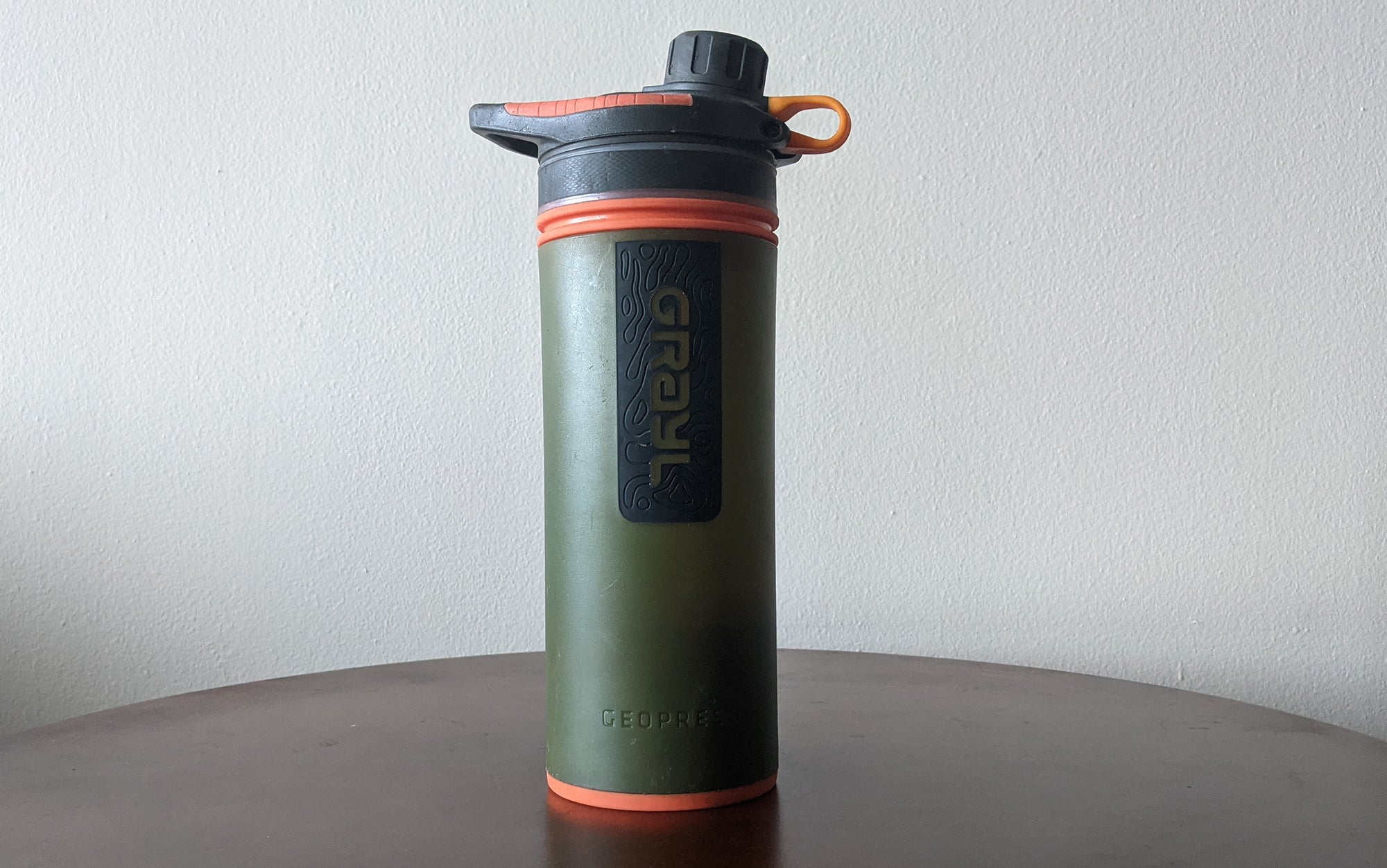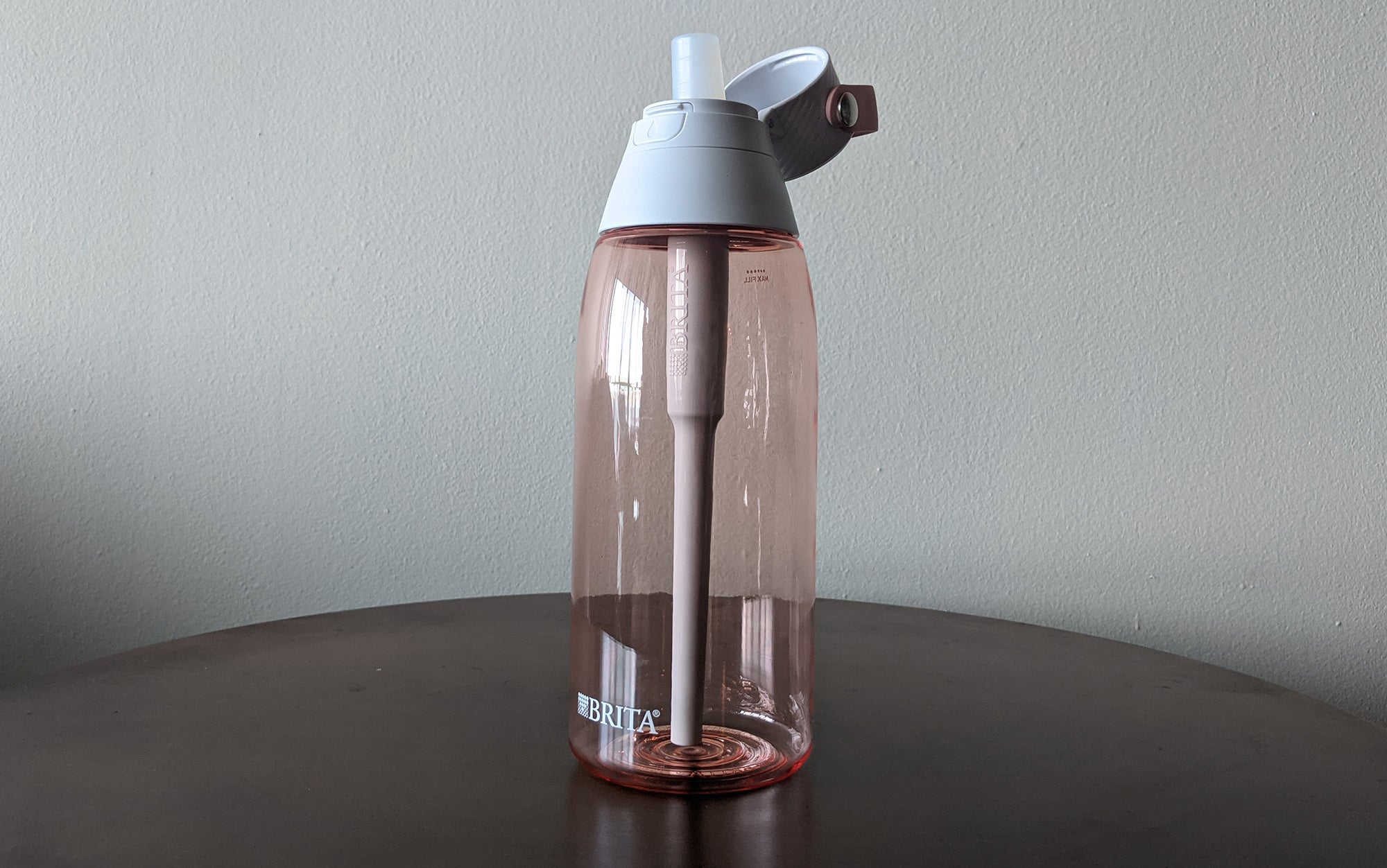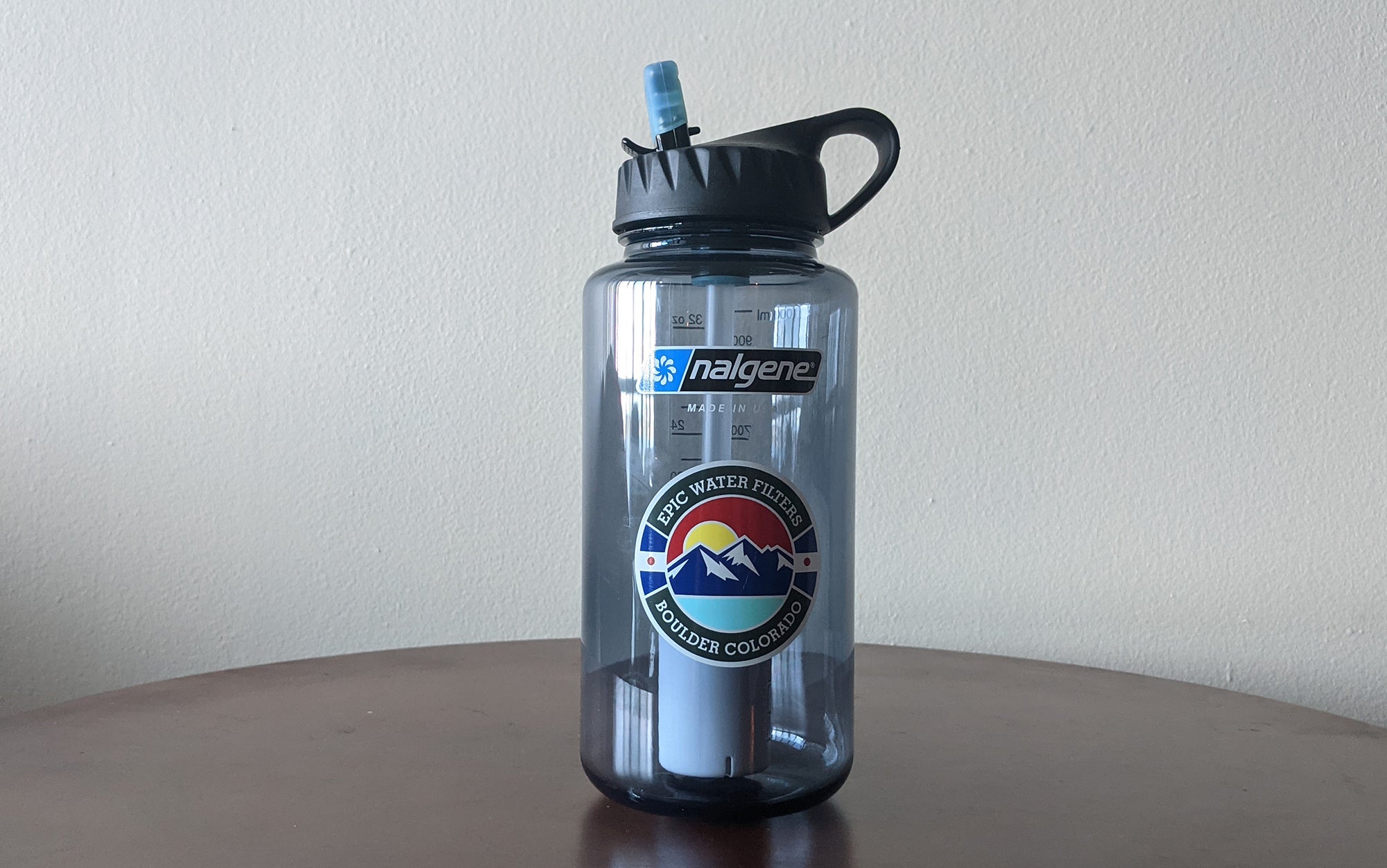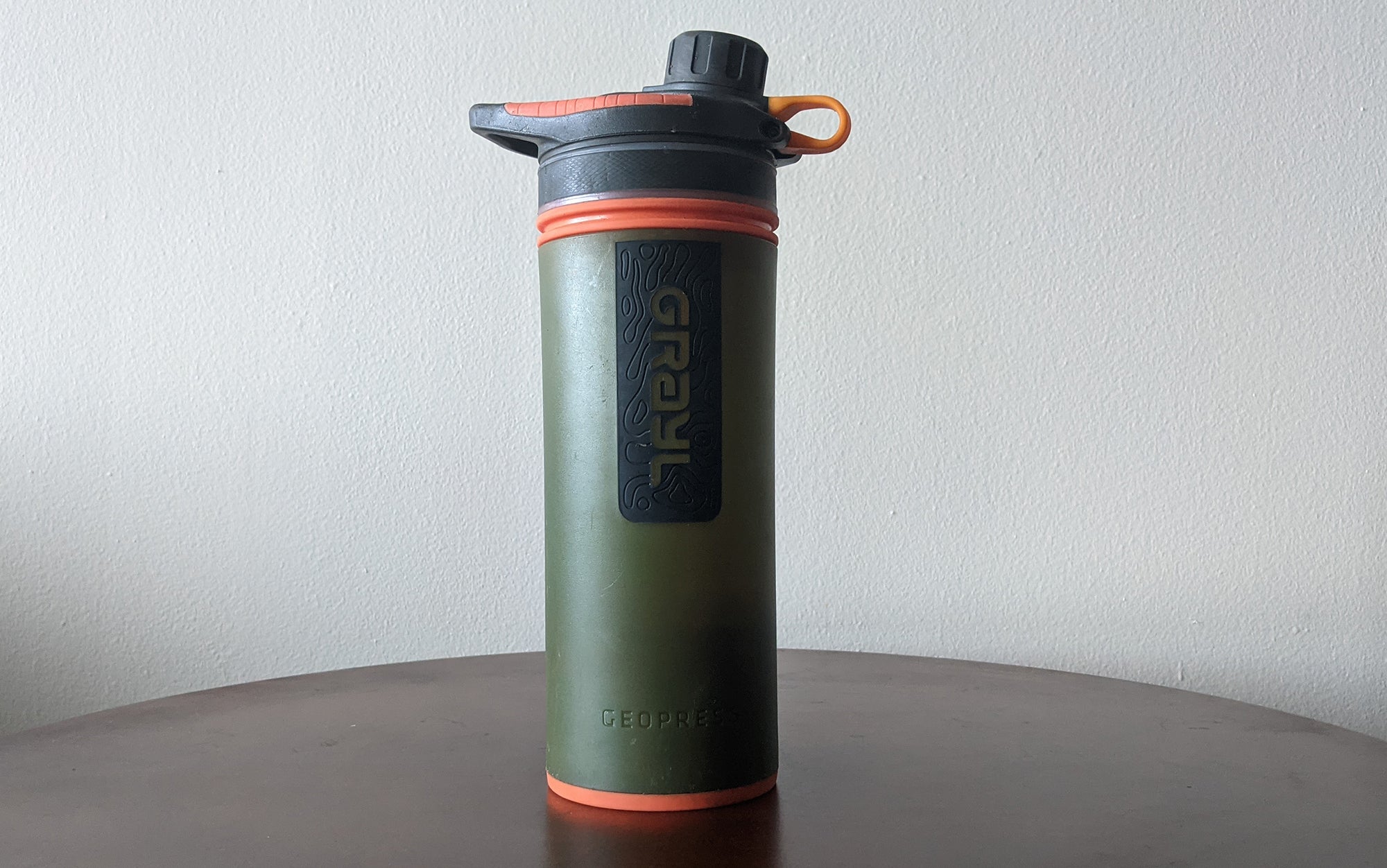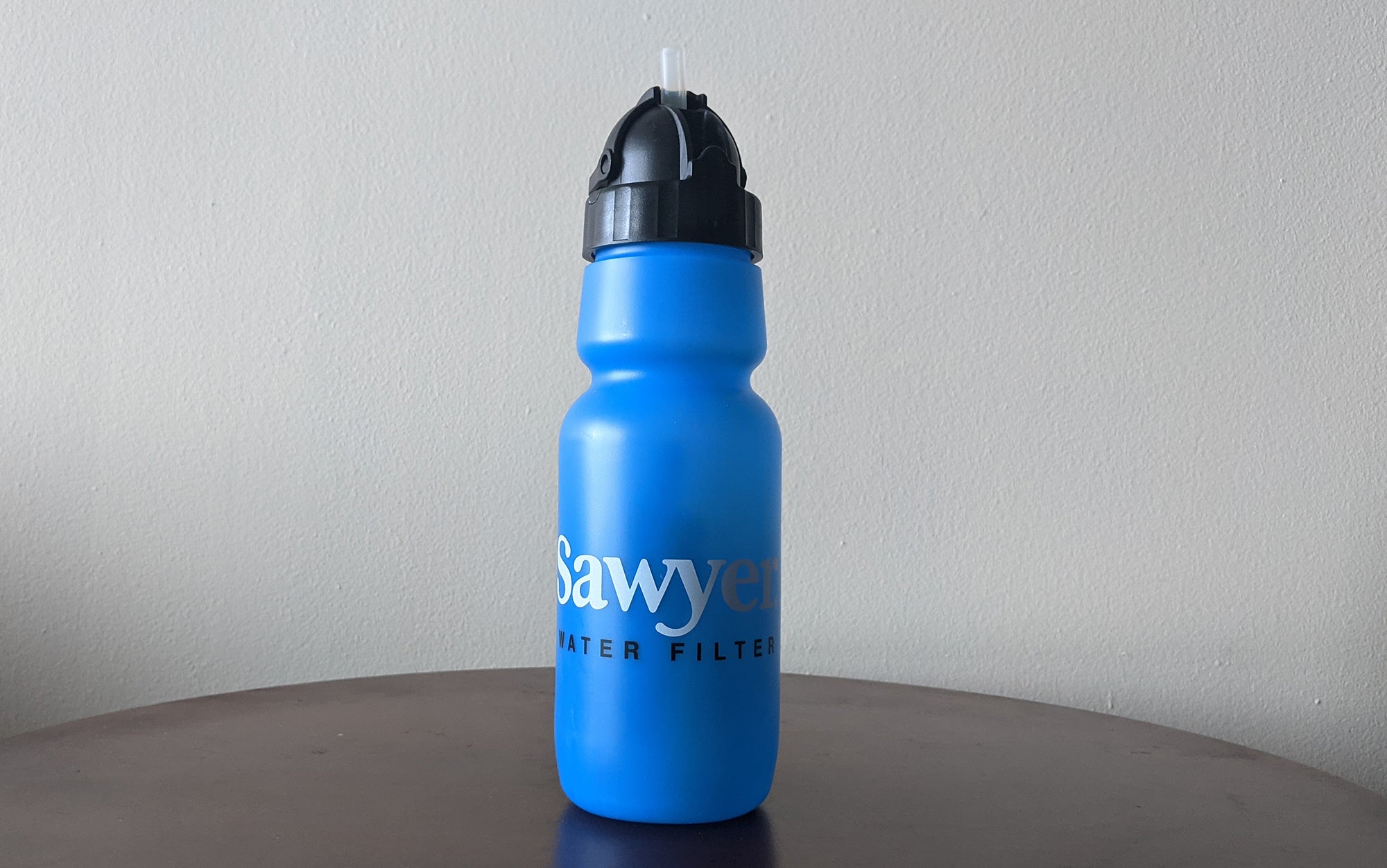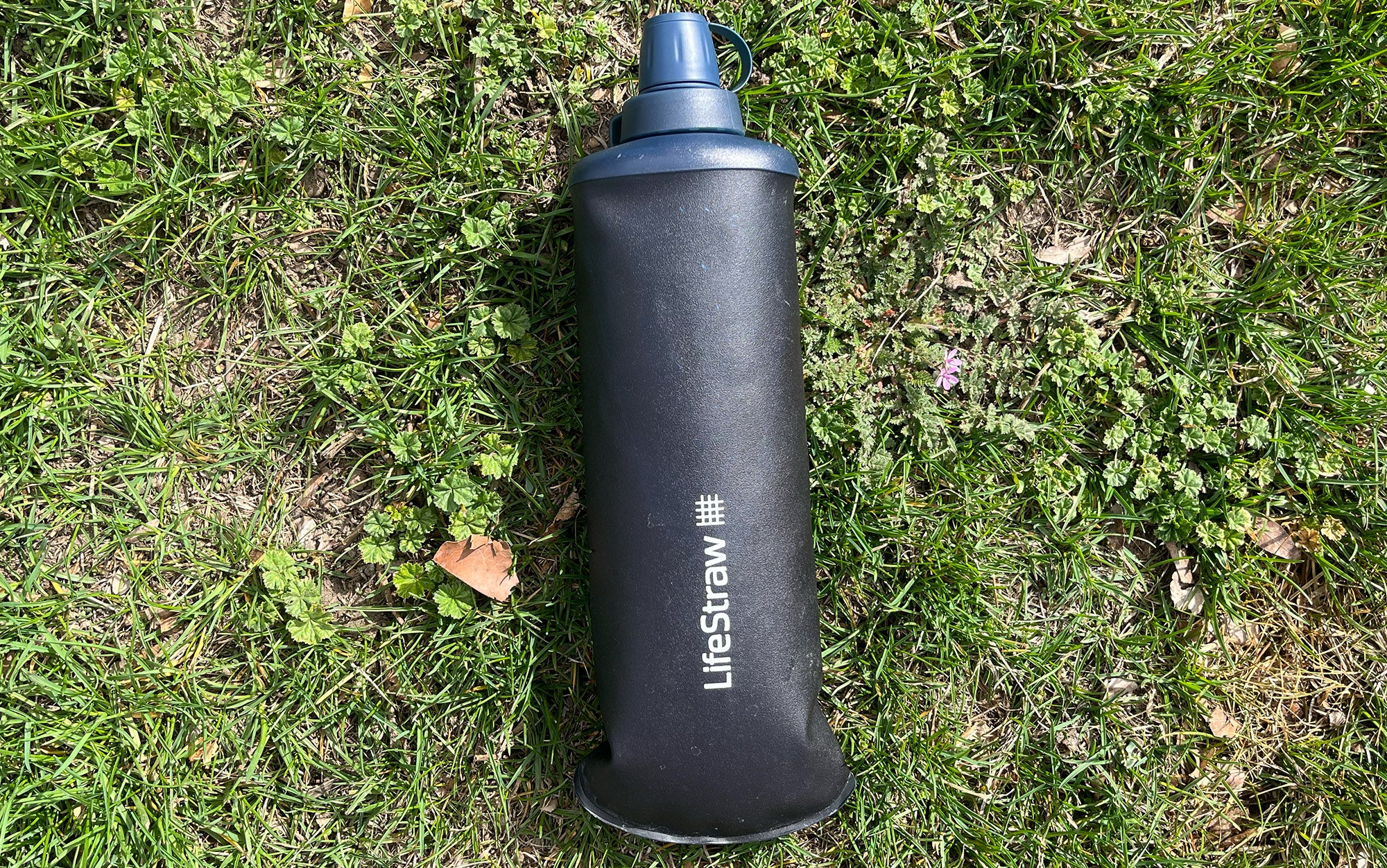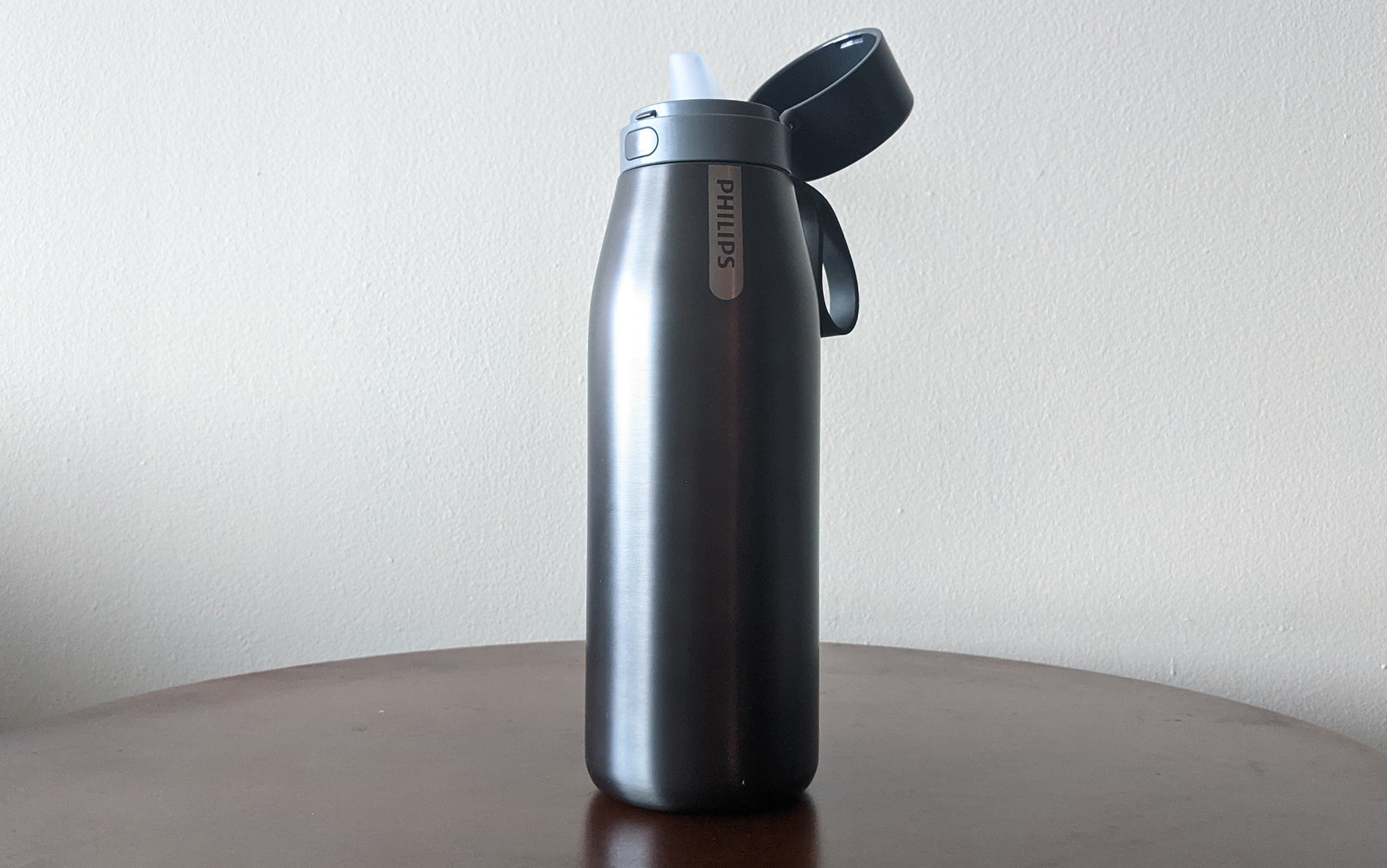The Best Filtered Water Bottles of 2023
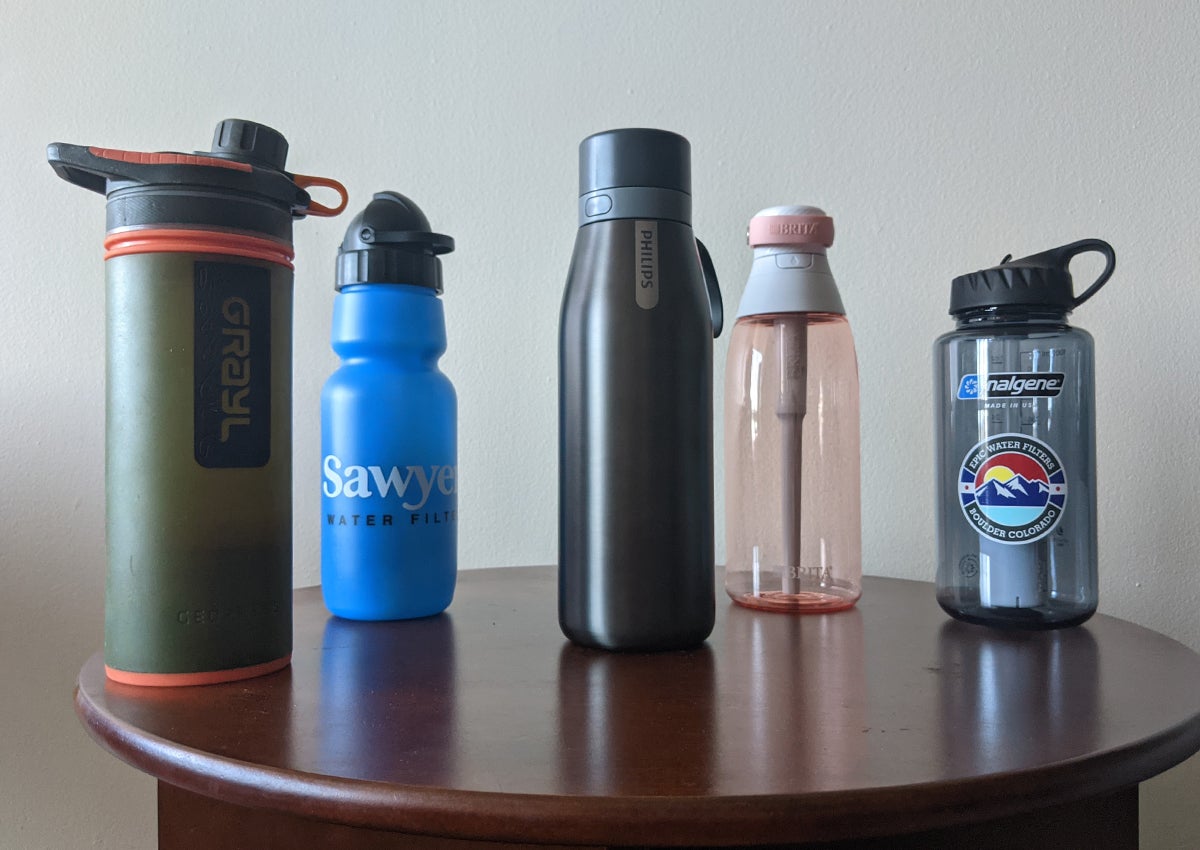
We may earn revenue from the products available on this page and participate in affiliate programs. Learn More ›
Filtered water bottles have become a must-have item for millions, and there are all kinds of reasons for wanting one. Maybe the water coming out of your tap is contaminated with lead. Maybe your well has PFAS. Or maybe you travel a lot to areas with regular norovirus outbreaks. Maybe you just hate the taste of chlorine in your water. To better understand which of the best filtered water bottles meet these different needs, I paired a deep dive on the certified testing done on each product with a field test to see which are the easiest and most enjoyable to use day to day.
- Best Overall: Epic Water Filter Epic Nalgene
- Best for International Travel: Grayl GeoPress
- Longest Filter Lifespan: Sawyer Personal Water Filtration Bottle
- Best Soft Bag: LifeStraw Peak Series Collapsible Squeeze Bottle
- Best Insulated: Philips Go Zero Everyday Bottle
- Best Budget: Brita Insulated Filtered Water Bottle
How I Tested the Best Filtered Water Bottles
The best filtered water bottle for you depends in large part on what your needs are. Some people have access to best-in-class municipal water and aren’t looking for anything more than a slight reduction in the taste of chlorine and other additives. Other people have more serious issues with the water coming out of their tap, including norovirus, lead, and PFAS. After considering your reasons for wanting a filtered water bottle, take a look at the below table to identify which of the bottles in this test meet your needs.
When looking at this chart, “no” means that there was no available testing data on whether a filtered water bottle was able to remove contaminants.
| Contaminant | Safe Level Standard | Grayl GeoPress | Sawyer Personal Water Filtration Bottle | LifeStraw Peak Series Collapsible Squeeze Bottle | Epic Water Filter Epic Nalgene | Brita Insulated Filtered Water Bottle | Philips Go Zero Everyday Bottle | Contaminant Type |
| Lead | .015 mg/L | <.005 mg/L | No | No | <.001 mg/L | No | No | Chemical Contaminants |
| Microplastics | N/A | 99.99% | 100% | 99.999% | 99.25% | No | No | Physical Contaminants |
| Chlorine | 4 mg/L | .4 mg/L | No | No | .02 mg/L | 2 mg/L | Yes | Disinfectants and Additives |
| Protozoa (e.g., giardia, cryptosporidium) | 99.9% | 99.997% | 99.9999% | 99.999% | 99.999% | No | No | Biological Contaminants |
| Bacteria (e.g., E. coli) | 99.9999% | 99.9999% | 99.99999% | 99.99999% | 99.9999% | No | No | Biological Contaminants |
| Viruses (e.g., norovirus, rotavirus) | 99.99% | 99.99% | No | No | 99.95% | No | No | Biological Contaminants |
| Atrazine (herbicide) | .003 mg/L | No | No | No | <0.00001 mg/L | No | No | Chemical Contaminants |
| Arsenic | .01 mg/L | 0.04987 mg/L | No | No | .0031 mg/L | No | No | Chemical Contaminants |
| Fluoride | 4 mg/L | No | No | No | .64 mg/L | No | No | Disinfectants and Additives |
| PFOA | 0.000004 mg/L | 0.00001 mg/L | No | No | <0.00001 mg/L | No | No | PFAS |
| PFOS | 0.000004 mg/L | 0.00003 mg/L | No | No | <0.00001 mg/L | No | No | PFAS |
The safe level standards in the above tables are pulled from a number of different governmental regulations. The chemical contaminant safe level standards and the disinfectant and additive safe level standards are expressed in milligrams per liter and are pulled from the EPA’s National Primary Drinking Water Regulations. The physical contaminant levels are expressed as the amount that they are able to remove in percent. At present there is no standard for what level of microplastics are safe to have in drinking water. The EPA standard for protozoa, bacteria, and viruses, biological contaminants, is 0, which is why chlorine is typically added to public drinking water supplies.
Water filters typically rely on the size of the gaps between the hollow fiber membranes (typically .1 micron, but can be as low as .01 micron) to remove protozoa and bacteria. The safe level standard for what percent of contaminants are left after being run through a given filter are from NSF Protocol P231, which is typically used for backcountry water filters. The PFAS safe level standards are expressed in milligrams per liter and are pulled from the EPA’s Proposed PFAS National Primary Drinking Water Regulation.
From talking to manufacturers of filtered water bottles, I learned that the testing is quite expensive, and that typically they end up paying for each chemical they test separately. As such, there may be instances in the above table where a filter is able to filter a specific chemical but the manufacturer simply did not have testing data to support this.
Next I looked at the cost, considering both the upfront cost and how the typical life of a unit and replacement cartridge costs would add up over the course of a year. I also conducted several tests to better understand how enjoyable each filtered water bottle was to use. For many people, the primary purpose of a filtered water bottle is to improve the taste of otherwise safe tap water, so that they can enjoy being more hydrated throughout the day. Others want to reduce the likelihood of purchasing bottled water to lessen their carbon footprint. For still others, it’s for health and safety.
During my field tests, I looked first at ease of use, identifying how easy or difficult it was to drink water from each filtered water bottle. For this test, I recruited my family, including my 4-year-old, to give me their feedback. Next I considered the taste of each filter, both when a filter was brand new and over the course of drinking several liters of water. I also checked how much water each filter was actually capable of holding by filling each to capacity and then pouring the water contained in each to an empty Nalgene. I then refilled each water bottle and drank as much as I could out of each, and then measured the water that was still left in the bottom, and deleted that from the usable amount of water in each bottle.
| Filtered Water Bottle | Stated Capacity | Upfront Cost | Filter Lifespan | Replacement Filter Cost | Field Tests | ||
| Ease of Use | Taste | Actual Capacity | |||||
| Grayl GeoPress | 24 ounces | $100 | 250 liters | $30 | Difficult (filtering); Easy (drinking) | Good | 24 ounces |
| Sawyer Personal Water Filtration Bottle | 34 ounces | $50 | 370,000 liters* | N/A | Fair | Good | 32 ounces |
| LifeStraw Peak Series Collapsible Squeeze Bottle | 34 ounces | $44 | 2,000 liters | $18 | Good | Good | 32 ounces |
| Epic Water Filter Epic Nalgene | 32 ounces | $46 | 285 liters | $30 | Fair | Good | 31 ounces |
| Brita Insulated Filtered Water Bottle | 36 ounces | $23 | 150 liters | $4 | Somewhat difficult | Good | 36 ounces |
| Philips Go Zero Everyday Bottle | 32 ounces | $30 | 150 liters | $5.50 | Somewhat difficult | Good | 32 ounces |
To further understand the performance of these filtered water bottles, I also looked at how easy they were to use, rating them for both the difficulty in pulling filtered water out of them and also looking at how difficult it was to remove and reset the cartridge. Finally, after cleaning each bottle thoroughly, I graded each on the taste of the water they produced.
Best Filtered Water Bottles: Reviews & Recommendations
Best Overall: Epic Water Filter Epic Nalgene
Laura Lancaster
Key Features
- Capacity: 32 ounces (stated); 31 ounces (actual)
- Filters out bacteria, protozoa, lead, nitrate, atrazine, PFOS, PFOA
- NSF/ANSI 42, 53, P231, and 401
- Filter Type: Nano fiber filter (outer) and carbon fiber filter (inner)
Pros
- Filters out a wide array of contaminants from microplastics to lead to PFAS
- Easy to search list of contaminants the Epic filters
- Subscription program makes it easier to remember to change your filter
- Made in the USA
Cons
- Pricier than other options I looked at
- Just falls short of providing adequate protection on virus filtering
As staff writer at Outdoor Life, most of my time evaluating products is spent out in the field, getting my hands dirty. That was not the case with the best filtered water bottles; instead, most of my time was spent trying to track down information on what testing had been done to validate a given filter’s ability to filter any number of contaminants, from PFAS to lead to chlorine to giardia. For several products, I had to query to track down the testing results.
The Epic water filter had some of the best transparency of any of the filtered water bottles I looked at. They had a chart on the product page on the website listing the percentage removal of various contaminants, and a link (somewhat buried but reasonably easy to find) to even more complete testing results. This may be overkill for individuals simply looking for some better tasting water, but if you have a specific contaminant you’re concerned about in your well water or municipal water supply, this chart is essential.
Something else I appreciated about Epic is that they have a discount set up on their website for ordering their filters as a subscription. One of the biggest reasons that filtered water bottles get a bad rap is that people don’t change out their filters often enough. If you’re using a filter that is meant to clean out contaminants like lead or PFAS, old filters may actually stop working. Filters that don’t filter out much beyond chlorine can end up with bacteria built up inside them over time, making them less healthy than if you were just drinking tap water.
In the field, the Epic was also one of the filtered water bottles I grabbed for most often. The Nalgene housing felt familiar in my hand and I liked that the straw was more of a rectangular shape than a circle. Functionally, it has about one ounce less capacity than it states (due to the space inside the bottle the filter is taking up), but that’s a minor quibble. While this filtered water bottle had a noticeably bad taste at the start of testing, it improved rapidly and was on par with the rest of the filters in my test by the second day.
Simply put, the Epic Water filter is an easy to use system that protects against virtually everything. The only Achilles heel that I ran across during my review of their data was that their filter only removes 99.95 percent of viruses, while 99.99 percent is the standard set by NSF P231, which is the standard used for health and sanitation. If you are traveling to a part of the world that has a known issue with norovirus or other virus contaminants, err on the side of caution and choose a filter that is known to remove those contaminants out to the correct decimal point, such as the Grayl GeoPress or the MSR Guardian.
Best for International Travel: Grayl GeoPress
Laura Lancaster
Key Features
- Capacity: 24 ounces
- Filters out bacteria, protozoa, viruses, microplastics, and chlorine
- NSF/ANSI 42 and 53
- Filter Type: Electroadsorption and ultra-powdered activated carbon
Pros
- Protects against viruses
- Easy to drink from
Cons
- Expensive
- Requires some elbow grease to run through the filter
If you are traveling to a part of the world where norovirus or rotavirus (or hepatitis A, or enterovirus) are known to be an issue, the Grayl GeoPress is the filtered water bottle for you. Not only is it the only filtered water bottle I looked at that was capable of handling viruses, but its counterpart, the UltraPress, also survived my test of the best backpacking water filters. In that test, I ran water filters through increasingly gnarly water conditions to see which were still capable of filtering on the other side. While slow at the end, the Grayl just squeaked by.
Unlike the other filtered water bottles in my test, the Grayl GeoPress does not rely on you to suck the water through the filter to function. There are a few advantages to this. First, it’s a lot less annoying to drink out of than other filtered water bottles. It can also be shared with other family members, including small children, without having to worry about whether or not they can create enough suction to make the filter work.
This filter works more like a french press. You fill the bottom reservoir with water, and then push the filter down on top of it. This works pretty well, but it does require some serious leverage. Typically I put the reservoir on the floor and then use my body weight to push down on top of the filter. That’s fine in my kitchen (and would also be in the backcountry) but it’s possible that you would be less excited to run through this operation if you were in a public setting, like an airport or a restaurant. Keep in mind your planned use before making a final purchase.
While Grayl does not currently have their testing specs listed online for consumers to check, they were able to send me data to verify the results in the above table.
Longest Filter Lifespan: Sawyer Personal Water Filtration Bottle
Laura Lancaster
Key Features
- Capacity: 34 ounces (stated); 32 ounces (actual)
- Filters out bacteria, protozoa, atrazine, and chlorine
- NSF/ANSI 42 and 53
- Filter Type: Hollow fiber membrane
Pros
- Filter can be used virtually indefinitely (with proper care)
- Easy to drink out of
Cons
- Testing on common contaminants, including lead, PFAS, and arsenic was unavailable
- More setup and pieces than other filtered water bottles I looked at
The Sawyer Mini (the filter inside their personal water filtration bottle) has long been a mainstay of backpacking and thru-hiking. It has an excellent reputation for keeping people safe from bacteria and protozoa (although not viruses) and is as effective as anything I looked at in reducing the taste of chlorine in tap water. Of all the filtered water bottles I tested, this one was the closest to drinking out of a regular straw, in terms of its design and its flow rate. It is also the only filter making one specific claim: 100,000 gallons.
I’m going to level with you: I don’t think backpackers are getting 100,000 gallons (370,000 liters) out of the Sawyer filters, or any filter for that matter. There is just too much muck in the water they are working with, too many other factors to account for, including the potential to damage or drop the filter. And while the original Sawyer filter was the only one in my test of the best backpacking water filters to wrap the test with a faster flow rate that it started with, the Sawyer Mini did experience a noticeable slowdown in flow rate, even after backflushing.
But that’s when it’s challenged with some of the grodiest water, full of muck and sediment, that I could find. If you’re filling your bottle out of the tap, it may very well last that long. While no one yet has tested one of Sawyer’s filters out to 370,000 liters, Messiah College did test the Sawyer out to 230,000 liters and found that it was still removing bacteria and protozoa past the requirements set by the EPA. If you drank 4 liters of water a day, it would take you over 150 years to drink that much water, so this seems like as close as you can get to a lifetime guarantee for a water filter.
Of course, this assumes regular care. The Sawyer Personal Water Filtration Bottle comes with a backflush plunger that you will need to hold onto, and use regularly, in order to preserve the flow.
Best Soft Bottle: LifeStraw Peak Series
Ashley Thess
Key Features
- Capacity: 34 ounces (stated); 32 ounces (tested)
- Filter out bacteria, parasites, and microplastics
- NSF P231
- Filter Type: Hollow-core membrane microfilter
Pros
- Collapsible
- Lightweight
- Long-lasting filter
Cons
- Doesn’t stand up
The LifeStraw Peak Series was assistant editor Ashley Thess’s pick for the best filtered option in her review of the best water bottles. Here’s what she had to say: Lightweight and collapsible, the LifeStraw Peak Series soft bottle is the perfect water bottle for borderline adventures. You know those long runs or hot days where your typical water bottle or bladder might not cut it. Bring this filtered squeeze bottle along just in case you need to replenish at a stream or lake. With this bottle you don’t have to bring a water filter and dirty bag just to refill your supply. There is also no need to contaminate a clean bottle with dirty water; the LifeStraw Peak is perpetually filled with unclean water and filters as you drink.
This wouldn’t be enough for me to filter water on a backpacking trip, but it is perfect for excursions where you’ll frequent watering holes or walk along a river so you can get away with carrying less liquid. The bag is ultra durable and doesn’t collect sand or dirt easily. The drinking nozzle is also protected by an attached dust cap. The attachment loop is helpful to hold the filtering cap on your finger so it doesn’t fall on the ground or in dirty water while filling. To keep the filter flowing properly, LifeStraw includes a syringe so you can backflush the filter to keep it clean.
Best Insulated: Philips Go Zero Everyday Bottle
Laura Lancaster
Key Features
- Capacity: 32 ounces (stated); 32 ounces (actual)
- Filters out chlorine
- Third-party testing only
- Filter Type: Activated carbon fiber
Pros
- Insulated construction keeps water colder longer
- Pop lid is satisfying to use
- Produces great tasting water
Cons
- Doesn’t filter out anything beyond large particles and chlorine
- Somewhat more difficult to drink out of than more expensive options
If your primary reason for wanting a filtered water bottle is to have great tasting water, the Philips Go Zero is a smart choice. Not only does it remove chlorine and particulates from water, ensuring it will taste great, but it’s also insulated, so your cold water will stay cold longer. Just keep in mind that this filter is not the right choice if you are concerned about the safety of your water, as it doesn’t remove bacteria, protozoa, viruses, lead, PFAS, or other dangerous chemicals.
Best Budget: Brita Insulated Filtered Water Bottle
Laura Lancaster
Key Features
- Capacity: 36 ounces
- Filters out chlorine
- NSF 42
- Filter Type: Activated carbon filter
Pros
- Comes in a variety of fun colors
- Insulated construction keeps water colder longer
- Pop lid is satisfying to use
- Produces great tasting water
Cons
- Doesn’t filter out anything beyond large particles and chlorine
- Somewhat more difficult to drink out of than more expensive options
Not only was the Brita Insulated Filtered Water Bottle the least expensive in my test, but it was also the favorite of my four year old. Was it the pink color? Probably, but those aesthetic choices should be top of mind when choosing a filtered water bottle, as the more you like your bottle, the more likely you are to actually drink from it. Unfortunately, it was slightly more difficult to drink out of, a function of the filter component being closer to the top of the filter than the bottom (the Philips GoZero also shared this unfortunate design), but this was only a nominal consideration. It filtered the chlorine taste out of my water just fine, even if that was the only thing that it managed to do.
Things to Consider Before Buying the Best Filtered Water Bottles
What Are You Trying to Filter?
As I learned while working on this story, it’s easy to call yourself a filtered water bottle and not filter out all that much. Before making a purchase, consider your reasons for making a purchase. Are you worried about lead? Bacteria Not everything labeled “filtered water bottle” is capable of removing these impurities. Check the bottle’s certifications and testing before making a final purchase. And if, at the end of the day, all you are really looking for is a filter that can make the water coming out of your tap taste a little bit better, that’s fine too—one of the more affordable options on this list will be a better match for what you are looking for.
Taste
Many people are looking for a filtered water bottle simply to improve the taste of their existing tap or well water. This is especially common for individuals who are drinking water from a municipal water supply. The EPA puts limits on 90 different contaminants for municipal water supplies, including arsenic and herbicides, However, chlorine is commonly used to neutralize any lingering bacteria or viruses, which can negatively impact the taste of the drinking water coming out of your tap, even though it is safe to drink. The chlorine has already killed biological contaminants so it’s safe to then filter it out for a less distinct flavor.
Ease of Use
A water bottle that is overly complicated to use will end up in the back of your cabinet in a matter of weeks. Consider your patience for refilling your bottle, changing the filter, and sucking the water through the filter before making a final choice.
FAQs
Q: Do filtered water bottles filter bacteria
Some filtered water bottles filter bacteria, but not all. Check your filtered water bottle’s certification (or refer to our chart, above), before making a final purchase.
Q: Is filtered water 100% free from germs?
Filtered water is not 100 percent free from germs, but it can get extremely close. The table above in this story shows which filtered bottles were capable of meeting EPA and NSF requirements for different contaminants.
Q: Is filtered water as clean as bottled water?
The reality is that it depends. Not all filtered water bottles are capable of removing heavy metals, which may be present in some well water. On the other hand, some bottled water has been found to be nothing more than repackaged tap water.
Q: How long do filtered water bottles last?
Filtered water bottles typically last about three months before they need to have their filter replaced, but that can vary depending on your own use and the type of filter employed. For instance, the hollow membrane filter that the Sawyer uses can be backflushed, so that it can be used virtually indefinitely.
Q: Can filtered water bottles remove heavy metals?
Some filtered water bottles are able to remove heavy metals, including lead, but many cannot. Check the testing and certifications of the filtered water bottle you are purchasing before making a final decision.
Q: Are purified and filtered water the same thing?
Filtered water and purified water are not well-defined terms, and different manufacturers and government agencies may treat them as interchangeable terms, or as completely separate processes. A better approach for consumers is to consider what (if any) contaminant they are most concerned about, and seek out a filter that brings that contaminant down to acceptable levels.
Why Trust Outdoor Life?
Since 1898, OL has been a leading authority in testing and reviewing hunting gear, fishing tackle, guns and shooting equipment, and much more. We have more than a century-long history of evaluating products, and we’re now bringing that expertise to online reviews. Our editors are experienced outdoorsmen and women, and most importantly, we’re trained journalists. We prioritize field testing and objective data when reviewing products. We conduct interviews with gear manufacturers and engineers as well as outdoor experts so that our readers have an understanding of how and why a product works—or doesn’t.
Advertising does not influence our gear reviews and it never will. While we always focus our coverage on standout products—because we want our readers to be aware of the latest and greatest gear—we also cover the flaws and quirks of any given product.
Final Thoughts
Whether you’re purchasing a filtered water bottle to prepare for international travel, deal with contamination in your home well supply, or just improve the taste of your daily drinking water, there are a variety of options available. Comparing your needs against the specs provided in the above table will help you to determine which water filter is ultimately right for you.
- Best Overall: Epic Water Filter Epic Nalgene
- Best for International Travel: Grayl GeoPress
- Longest Filter Lifespan: Sawyer Personal Water Filtration Bottle
- Best Soft Bag: LifeStraw Peak Series Collapsible Squeeze Bottle
- Best Insulated: Philips Go Zero Everyday Bottle
- Best Budget: Brita Insulated Filtered Water Bottle
The post The Best Filtered Water Bottles of 2023 appeared first on Outdoor Life.
Articles may contain affiliate links which enable us to share in the revenue of any purchases made.
Source: https://www.outdoorlife.com/gear/best-filtered-water-bottles/


